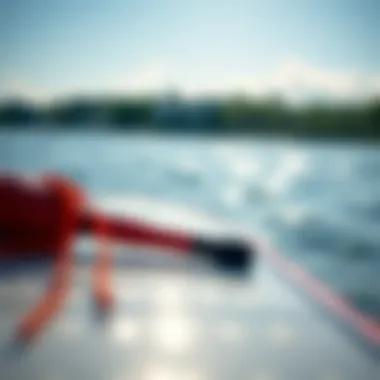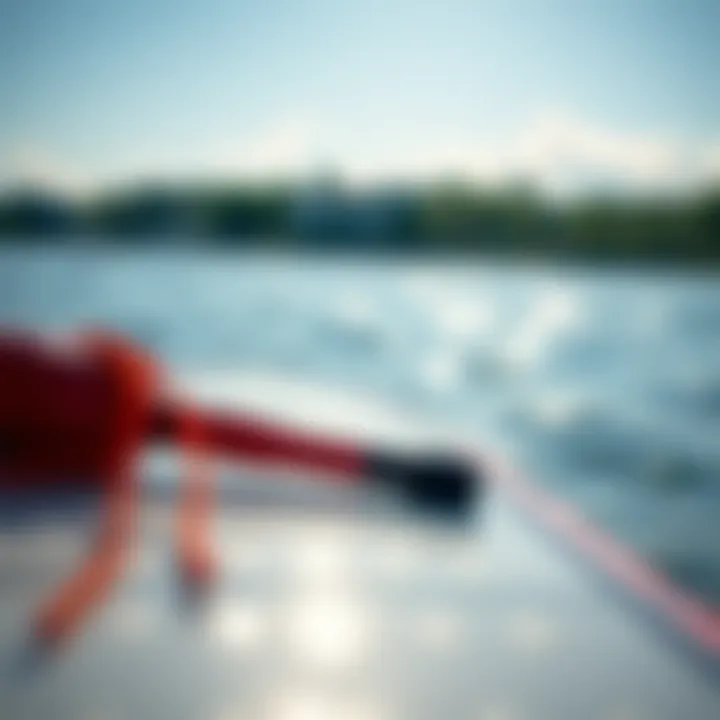Discovering the Benefits of Small SUP Boards


Intro
In recent years, small stand-up paddle boards (SUPs) have carved a niche for themselves in the water sports arena. These boards aren't just a passing trend but represent a significant evolution in paddle sports, blending performance, versatility, and accessibility. Whether you're a weekend warrior seeking leisure or an aspiring competitor aiming for podium finishes, small SUP boards offer unique features that make them worth exploring.
A small SUP board typically ranges from 8 to 10 feet in length, striking an ideal balance between stability and maneuverability. But why consider these boards over their longer counterparts? The answer lies in their advantages, which appeal to various skill levels, from novices to seasoned pros. The compact design facilitates a more intimate connection with the water, allowing tight turns and sharp maneuvers that many paddle enthusiasts crave.
As we navigate through this guide, we will break down the essential aspects of small SUP boards—from their design characteristics and potential benefits to practical maintenance tips and their cultural significance in the surfing community. Additionally, we'll address common concerns and considerations for prospective buyers to make informed decisions. Navigating the waters of small SUPs becomes much easier with knowledge and insight in your corner.
Intro to Small SUP Boards
Stand-up paddleboarding (SUP) has become a popular water activity across the globe. The sport has grown significantly, with various types of boards available to cater to different enthusiasts. This article zeroes in on small SUP boards, which boast unique traits that set them apart from their larger counterparts.
Small SUPs are generally defined as boards under 10 feet in length. Their compact size offers advantages for both novice and seasoned paddlers. They can be easily transported, making them ideal for traveling enthusiasts. Furthermore, small SUPs are incredibly versatile, suitable for a variety of water conditions such as calm lakes, rivers, and even surf.
In the quest for maintaining an active lifestyle, small SUP boards represent a great conduit. Whether you're looking to relax on a lake or catch a few waves, they provide an exciting way to engage with nature. People of different skill levels find enjoyment in these boards, which allows for a more inclusive paddling experience compared to the traditional larger boards.
With these points in mind, this exploration intends to unravel the many facets of small SUP boards. From their key features to the advantages they offer, understanding small SUP boards will enhance your experience on the water.
Definition and Overview
Small SUP boards can be succinctly described as Stand-Up Paddleboards designed for maneuverability and ease of use. Generally, they measure between 8 to 10 feet in length and can weigh less than 20 pounds. This compactness makes them light as a feather compared to traditional boards, promoting accessibility for those new to the sport.
Designed primarily for flat and small wave conditions, small SUPs have gained traction among diverse user groups. From the leisurely paddler to the adrenaline-seeker, these boards hold a special place in the SUP community. The smaller size allows for quick turns and an easier time balancing, making them a perfect pick for individuals who wish to dabble in both recreational paddling and surf.
The Evolution of Stand-Up Paddleboarding
The roots of stand-up paddleboarding can be traced back to ancient cultures, where paddlers used large boards to navigate water bodies, largely for fishing and transport. However, modern SUP gained momentum in the early 2000s, particularly in Hawaii. Initially, SUP boards were significantly larger, designed mainly for stability.
As the sport matured, so did the design of boards. The emergence of smaller SUP boards was a response to the demand for a more dynamic paddling experience. These boards cater to specific skill levels and water conditions. The shift from traditional longboards to compact, lightweight options enabled more maneuverability and a broader appeal.
Key Features of Small SUP Boards
When it comes to small stand-up paddle (SUP) boards, understanding their key features is crucial for anyone wanting to make an informed decision in choosing a board that meets their needs. Small SUP boards are not just miniature versions of their larger counterparts; they bring unique benefits and advantages that contribute to a distinct paddling experience. By focusing on dimensions, materials, and design elements, this section aims to shed light on how these aspects enhance performance and enjoyment on the water.
Dimensions and Weight Capacity
The dimensions of a small SUP board significantly influence its purpose and usability. Typically ranging from 8 to 10 feet long, these boards offer a balance between stability and maneuverability. The narrower boards, often around 28 to 32 inches wide, are ideal for speed and agility, making them great for surfers looking to ride swells. Just as a nimble dancer glides across the floor, a properly sized small SUP lets an experienced paddler gracefully navigate tight turns.
Weight capacity is another prime consideration. Most smaller boards can handle between 180 to 250 pounds, although this can vary based on the specific model and materials used. It's vital for paddlers to carefully assess their weight and gear combined to ensure they choose a board that can float them comfortably. After all, a board that struggles under the weight can lead to less than ideal performance on the water.
Important Consideration: Always double-check the manufacturer's specifications on weight limits before purchasing to avoid any mishaps in the water.
Material and Construction Types
The construction of small SUP boards plays a pivotal role in durability, weight, and performance. Common materials used are epoxy, plastic, and inflatable technology. Each brings its own set of advantages:
- Epoxy Boards: Known for their stiffness and lightweight nature, epoxy boards offer excellent performance in terms of speed and agility. They often feature a foam core surrounded by layers of fiberglass or epoxy resin, making them tough yet responsive.
- Plastic Boards: While heavier than epoxy, plastic boards provide durability and are often more affordable. They can withstand more abuse, making them suitable for beginners or those just wanting a casual day on the lake.
- Inflatable SUPs: Thanks to modern technology, inflatable boards have gained immense popularity. They’re easy to transport and store and tend to be more forgiving when it comes to impact. Blowing up a board might seem like a chore, but the convenience they offer often outweighs the effort.
Choosing the right material depends significantly on what a paddler is looking for, whether that is performance, budget, or convenience.
Design Elements
Design elements are where the small SUP really shines. They are crafted not only for aesthetic appeal but, more importantly, to enhance functionality and paddler experience. Many boards feature unique graphics and colors that resonate with different lifestyles, turning heads both on and off the water.
Key design considerations include:
- Tail Shape: Different tail shapes influence the board's performance in varying conditions. A pointed tail offers better tracking, while a wider tail provides improved stability. Paddlers should think about where they’ll be most frequently paddling before making this choice.
- Rocker Profile: The curvature of the board varies significantly and can affect how it rides. A greater rocker allows for smoother turns and better performance in waves, while a flatter board excels at speed. Finding the right balance can set the tone of the entire water journey.
- Deck Pad: A comfortable and non-slip deck pad can make a world of difference during long paddling sessions. The texture and grip of the pad help keep footholds secure, ultimately influencing the overall paddling experience.


In summary, small SUP boards offer a variety of features that collectively enhance performance, stability, and enjoyment on the water. Understanding dimensions, materials, and specific design elements facilitates a more informed decision-making process, empowering paddlers to choose a board that not only fits their skill level and preferences but also enhances their adventures.
Advantages of Small SUP Boards
Small stand-up paddle boards, often referred to as small SUPs, bring a medley of advantages that cater both to casual users and seasoned paddlers. Understanding these perks is crucial in appreciating why many enthusiasts prefer smaller boards over their larger counterparts. Whether it’s about portability, usability, or performance, small SUPs have got it covered.
Portability and Storage
When it comes to portability, small SUP boards shine like a beacon. Their compact design makes them relatively easy to carry, store, and transport. You can haul one of these boards on your roof rack without transforming your car into a rolling circus.
Stowing them away is equally hassle-free. Small boards fit snugly in tight spaces, whether that's in a parked car, garage, or even an apartment. This is especially beneficial for those living in urban areas where space is often a luxury. In addition, their lightweight nature—even the inflatable variants—adds to the ease of carrying them to your favorite water spot. It's like packing a lightweight backpack; you don't even realize you’re carrying anything after a while.
Key Benefits of Portability:
- Easy Transport: Light and compact make for simple carry, whether by hand or on a vehicle.
- Convenient Storage: Ideal for those limited on space, can be tucked away neatly.
- Quick Setup: Less time fumbling with gear means more time on the water.
Versatility in Usage
The beauty of small SUP boards lies in their versatility. These little marvels can handle a spectrum of activities including casual paddling, yoga sessions, and even competitive racing. From flat-water lakes to gentle waves, the adaptability of smaller boards can accommodate a variety of paddling styles and environments. They’re particularly perfect for new paddlers who might want to explore different water conditions without investing in various types of boards.
Additionally, small boards cater to diverse user profiles. This means families can enjoy a day on the lake, while more advanced users can test their skills navigating small waves without having to switch boards. They serve well in training sessions for skills, and also function efficiently for a calm, meditative paddle on a quiet morning.
Noteworthy Advantages of Versatility:
- Multi-Purpose Use: Suitable for various activities ranging from fitness exercises to leisure.
- Skill Development: Ideal for learners, encouraging exploration across different paddling styles and conditions.
- Family-Friendly: Offers something for everyone, making it easy to enjoy group outings.
Enhanced Maneuverability
The aptly narrow design of small SUP boards affords superior maneuverability. This attribute is invaluable, especially in crowded waters or when carving through tight spaces. Paddlers can change direction more swiftly, making the experience more engaging and dynamic. Navigating around obstacles or other watercraft becomes a breeze, and that sense of control can greatly enhance your overall paddling experience.
Furthermore, their agile design simplifies tricks and turns. For those interested in paddleboarding stunts, small boards allow for easier balancing and shifting of weight, making it possible to execute impressive moves without needing a large surface area. As any surfer knows, the closer you are to the water, the better your connection with it—small boards provide just that.
Key Points on Maneuverability:
- Quick Direction Changes: Suitable for multi-directional paddling, avoiding obstacles effortlessly.
- Skill-Enhancing Design: Good for practicing tricks and improving paddle control.
- Intuitive Handling: Feels like an extension of the body, fostering better interaction with water.
For further reading on paddleboard adaptability and design innovations, check out resources such as Wikipedia and Britannica.
Selecting the Right Small SUP Board
Choosing the right small stand-up paddle board, or SUP, is a crucial undertaking for anyone looking to get the most out of their paddling experience. A mismatched board can hinder your enjoyment and even impact your safety on the water. Understanding the specific elements that shape your decision can help enhance your overall performance and fun.
The process of selecting a small SUP board involves a few key considerations that go beyond just picking a trendy design or attractive color. By taking into account your skill level, intended use, and local water conditions, you can hone in on a board that precisely fits your needs.
Assessing Skill Level and Experience
When it comes to skill level, you don’t want to bite off more than you can chew. If you’re just getting your feet wet, it might be wise to choose a board that offers more stability and buoyancy. Novice paddlers typically will benefit from a broader, sturdier design. Boards that have a greater width provide much needed balance, easing those wobbly first attempts.
For those who are a bit more seasoned, a smaller and narrower board may enhance speed and agility. Still, the choice largely depends on personal equilibrium with both strength and confidence on the water. Here’s a rundown of what to think about:
- Beginner: Look for boards that are wider, thicker, and around 10 to 12 feet long. This stability will support learning fundamental paddling and turning techniques.
- Intermediate/Advanced: Sleeker and less bulky boards that provide a quicker and more nimble experience might be more appealing. Boards from 8 to 10 feet can set you up for fast-paced performance, should your balance allow for it.
Understanding Intended Use
What you aim to do with your small SUP board can drastically change what features you should look for. Different activities call for different specifications, and keeping your goals in mind is paramount. Are you gearing up for a leisurely paddle on calm lakes, aiming to tackle some surfing waves, or hunting for a board suitable for touring?
- Recreational Paddling: If you’re merely looking to float and enjoy the sights, prioritize stable boards that offer comfort.
- Surfing: A shorter, thinner board with a pointed nose will allow for swift turns on waves while maintaining speed.
- Fitness and Yoga: Opt for boards that are wide enough to ensure balance during workouts, while potentially incorporating features like non-slip surfaces.
Considering Local Water Conditions


Lastly, the local waterways where you’ll be paddling can greatly affect your choice. Paddling on calm lakes requires something entirely different than tackling swift rivers or navigating choppy ocean waters. Assess the following factors about your paddling environment:
- Flat Water: For flat lakes or calm bays, choose a wider board for stability.
- Rough Waters: More streamlined boards with a pointed nose can cut through waves more effectively and are appropriate for the challenges offered in ocean or river waters.
"Choosing the right small SUP board is like picking the right shoe for a journey; comfort and fit can make or break the experience."
By accounting for your skill level, intended use, and local environment, you position yourself to make a well-rounded decision on a small SUP board. It is not just a matter of aesthetics; it's a nuanced choice that can enhance your time on the water and help you flourish in your paddling journey.
Maintenance and Care of Small SUP Boards
Looking after small stand-up paddle boards is essential to prolong their life and maximize the enjoyment they give from water adventures. Just like you wouldn’t let your car rot in the driveway, a bit of care turns what might seem like a simple piece of gear into a reliable companion on the waves. Let's dive into the specifics of maintaining and caring for your small SUP board.
Cleaning Techniques
Keeping your SUP board clean isn’t just about aesthetics; it has a bearing on its performance and durability, too. After each paddling session, you’re wise to give it a good rinse. Saltwater and sand can be unforgiving, leaving spots that gnaw away at your board’s finish. Here’s a few straightforward tips on how to keep your board sparkling:
- Fresh Water Wash: As soon as you return from your adventure, start by spraying the board down with fresh water. This removes salt, dirt, and other muck without damaging the material.
- Mild Soap Cleanup: For tough stains, a mix of mild soap and water can do the trick. Use a soft sponge or cloth to scrub the areas gently—aggressive cleaning might leave scratches.
- Dry it Down: Ensure that no water pools can remain on the board. Wipe it down with a soft towel to prevent water spots and minimize mold growth.
- Avoid Sun Exposure: It’s best to clean your board in the shade. Direct sunlight might fade colors and finish over time.
"Regular maintenance doesn’t just preserve the board's appearance; it enhances safety by ensuring it's in top shape for the next trip."
Storage Recommendations
Storing your SUP board properly can extend its life dramatically. Just tossing it in the garage isn’t going to cut it. Here’s how you might want to go about it:
- Vertical Storage: If you can, stand your board upright against a wall. This keeps it off the ground and away from bumps and scrapes. Make sure it’s secured to prevent it from tipping over.
- Use a Board Bag: Investing in a good board bag will help protect it from dust, dings, and UV rays. It’s like wrapping your car in bubble wrap before parking it.
- Temperature Control: Try to store your board in a climate-controlled area if possible. Extreme temperatures—both hot and cold—can warp the materials and affect performance.
- Avoid Concrete Floors: Concrete can absorb moisture and then transfer that to your board. Consider placing the board on a shelf or a wooden platform instead.
Identifying Signs of Wear
A well-loved SUP board will show signs of wear over time, and it’s critical to keep an eye out for any that could compromise your future paddling sessions.
- Cracks or Dents: Even small impacts can create stress fractures. Check for these regularly—those little cracks might mean trouble down the line.
- Peeling or Fading: If the paint is peeling or the colors are significantly fading, not only does it look rough, but it also suggests the protective layers are wearing thin, leaving your board vulnerable.
- Soft Spots: If any part feels softer than the rest, it’s a sign that water has gotten inside. This kind of damage can affect buoyancy and performance, so addressing it straight away is crucial.
- Check the Fin: Examine the fin for any breaks or irregularities. A damaged fin can change how the board tracks in the water, affecting both handling and safety.
By implementing these maintenance practices, you can ensure your small SUP board not only looks good but performs well for years to come. Regular care and attention can make all the difference in maximizing your time on the water.
Experiencing Small SUP Boards on Water
The allure of small stand-up paddle boards (SUPs) lies primarily in their capacity to deliver unique experiences on various types of water. The dynamics of paddling, however, extends far beyond merely balancing on the board. It encompasses a profound understanding of the water, navigation techniques, and the social aspect of shared experiences. Let’s explore the nuances of paddling, whether you’re just starting or seeking to hone your skills in a group setting.
Beginner Tips for Paddling
For those who are new to the world of paddling, there are some first steps that can make all the difference. Here are a few beginner tips:
- Posture: Stand upright with feet shoulder-width apart, knees slightly bent. Keep your core engaged for stability.
- Grip: Hold the paddle with one hand on top and the other at the T-grip. Maintain a relaxed grip to prevent fatigue.
- Paddle Stroke: Use a long stroke to maximize distance. Ensure to keep the blade vertical and pull through the water, rather than splashing.
- Turning: Sharper turns can be achieved by paddling on one side more than the other. A quick pivot may come in handy for dodging obstacles.
- Practice Falling: Don’t fear a tumble; it’s part of learning. Falls should be embraced, not avoided. Understanding how to get back on your feet after falling is key.
Incorporating these tips will help beginners feel more confident and comfortable on the water, making the experience enjoyable and fulfilling.
Advanced Techniques for Experts
For experienced paddlers, pushing limits and refining techniques is where the real excitement resides. Advanced techniques can help you tackle waves, navigate tricky waterways, and harness the strength of your paddling for greater efficiency. Here are some insights:
- Stroke Efficiency: Focus on your technique to increase your stroke efficiency. A correct stroke sequence goes like this: enter, catch, pull, exit, and recover. Mastering this will save energy while maximizing speed.
- Bracing: Learn to brace during waves or turns to maintain balance. A well-executed brace can prevent falls in rough waters and maintain momentum.
- Reverse Paddling: Occasionally, it’s necessary to paddle backward. This technique can help avoid obstacles or maintain position without turning the board around.
- Downwinding Technique: If you get the chance on a windy day, try downwinding. This technique uses the wind and swell to propel you forward efficiently, adding an exciting twist to your session.
- Surfing the Waves: Engaging with small waves can be exhilarating. Picking the right wave and timing your paddle can lead to thrilling rides, enhancing your overall experience.
Mastering these elements will not only elevate your paddling prowess but will deepen your connection with the water.
Group Paddling Dynamics
Paddling is often more than just an individual pursuit; it becomes a communal activity. Group paddling provides a unique set of dynamics that is both engaging and enjoyable.
- Communication: Always communicate with your group. Use clear signals to indicate turns or stops. This is essential for maintaining safety and synchronizing paddling.
- Pacing: Keep a steady pace for the whole group. It’s crucial not to leave anyone lagging behind, as it can disrupt the collective experience.
- Formation: Consider forming a line or a staggered group, depending on water conditions. This allows everyone to feel connected while minimizing disturbances to individual paddlers.
- Shared Responsibility: If someone is struggling, lend a hand or share tips. Helping each other enhances the bond among paddlers and enriches the group experience.
- Environmental Awareness: While paddling with a group, ensure everyone is conscious of keeping the environment pristine. Collecting any litter encountered is a great way to embody a responsible paddler mindset.


By embracing these dynamics, group paddlers can cultivate an enriching environment that not only enhances skills but strengthens friendships, fostering a sense of community on the water.
"Paddle not only for yourself but also for those with whom you share the water. Together, we create memories that last beyond the waves."
Experiencing small SUP boards in varied ways allows paddlers to unlock the true essence of their adventures. This connection to both the craft and the community should ultimately be what keeps enthusiasts coming back for more.
The Cultural Impacts of Small SUP Boards
The small stand-up paddle board (SUP) is more than just a piece of equipment; it represents a cultural movement within the watersports community. As small SUP boards gain popularity, they contribute to various social and environmental aspects that deserve attention. They have become a tool for fostering community, promoting ocean stewardship, and shaping new traditions among enthusiasts.
Community Engagement Through Paddling
Small SUP boards help to bridge gaps across people of all ages and backgrounds. Local paddling groups and clubs have sprouted up, acting as hubs for enthusiasts to connect and share experiences. Whether it's via a casual meetup at a lake or an organized event at the beach, these gatherings foster camaraderie among paddlers. Individuals who may never have crossed paths otherwise find common ground through their love of paddling.
Key Elements of Community Engagement:
- Local Competitions: Friendly competitions, often informal, motivate both seasoned paddlers and newcomers to improve their skills.
- Social Media Groups: Online forums and platforms like Facebook and Reddit allow users to swap tips or find partners for paddling.
- Paddle for a Cause: Many groups organize events that not only promote paddling but also raise awareness for issues such as water quality or marine life protection.
By nurturing these connections, small SUPs play a pivotal role in molding a supportive and inclusive culture where everyone can find their place.
Contributions to Ocean Conservation
Small SUP boards are not just a means of leisure; they can actively contribute to ocean conservation efforts. These boards provide enthusiasts with a unique opportunity to observe marine ecosystems up close, leading to greater appreciation and understanding. As paddlers glide over the waters, their interactions often spark a desire to protect these environments.
How Small SUP Boards Contribute:
- Citizen Science Participation: Paddlers often collect data on marine wildlife and water quality, feeding valuable information back to conservationists.
- Awareness Campaigns: Paddleboarding events sometimes incorporate educational talks about climate change, plastic pollution, and the importance of marine conservation.
- Clean-up Initiatives: Many paddling groups organize clean-up events that not only beautify the water but also raise awareness about pollution's impact.
Challenges of Using Small SUP Boards
Navigating the world of small stand-up paddle boards (SUPs) comes with its set of hurdles. While these boards are favored for their agility and ease of transport, potential users must be mindful of various challenges. In this section, we’ll dissect some critical aspects that cater to both novice paddlers and seasoned enthusiasts, focusing on weather and water conditions, and comparisons with other board sizes.
Weather and Water Conditions
The influence of weather and water conditions can’t be overstated when choosing the right small SUP board. This isn't just about finding the sunniest days; it’s about knowing how elements interact with your paddling experience. Factors such as wind, waves, and water temperature can greatly affect maneuverability and stability on a small board.
- Wind: A brisk breeze may seem harmless but can turn into a paddle challenge, especially if you're on a more petite board. Not only does it make paddling more strenuous, but wind can also create choppy conditions. Beginners might find themselves wresting with their balance. It’s wise to stick to calmer days while learning the ropes.
- Waves: Larger boards typically perform better in rough waters. Small SUPs might struggle against waves; they can get tossed around, which isn’t ideal for an enjoyable ride. Surf conditions should be assessed carefully, as even moderate waves can push a small board to its limits.
- Water Temperature: Cold water can be daunting; no one wants to take an unplanned dip. Small boards often mean less stability, which can lead to a spill during entry or exit. It’s recommended to consider insulated gear or choosing warmer conditions, especially for less experienced paddlers.
A significant understanding of weather patterns can tip the scale between a successful day on the water and a challenging endeavor.
Comparison with Other Board Sizes
Understanding how small SUP boards stack up against their larger counterparts brings clarity into their strengths and limitations. While the mobility of smaller boards is attractive, they come with trade-offs that are worth considering.
- Stability: Larger boards provide a wider stance, ensuring greater stability, particularly in uneven waters. Those using small boards need to have a solid sense of balance. In contrast, beginners might feel more at ease on wider, longer boards where stability reigns supreme.
- Paddle Technique: Smaller boards often require a more refined paddling technique for optimal maneuvering. When compared to larger boards that can accommodate a more relaxed paddling style, small boards necessitate a calm focus on form and stroke, particularly in dynamic environments.
- Speed and Agility: There's no denying that small SUP boards edge out larger models when it comes to swift turns and quick movements. Their lighter frames allow skilled paddlers to navigate tighter spaces with finesse. However, this agility can become a double-edged sword if an unexpected wave or gust of wind arises.
- Weight Limitations: Smaller boards may have a lower weight capacity, which can exclude heavier individuals or those carrying gear. It’s crucial to know your board’s limitations. A larger board can better support various body types and equipment, providing an inclusive experience.
Epilogue: The Future of Small SUP Boards
The future of small stand-up paddle boards (SUPs) is not just about sleek designs or flashy graphics; it's a reflection of evolving needs and desires among paddlers. As the sport matures, these boards increasingly address both practical and environmental considerations, ensuring that they remain relevant and adaptive in a changing world. From recreational paddlers to serious competitors, the innovations in small SUP boards cater to diverse demands.
Innovation in Design and Technology
The landscape of small SUP boards is seeing remarkable advancements. Manufacturers have started to blend technology with traditional craftsmanship, resulting in lighter, more durable, and efficient products. One striking element is the growing use of eco-friendly materials. This shift not only meets consumer demand but also supports the environment, aligning with the values of many paddlers today.
- Advanced Materials: Boards are being constructed using combinations like carbon fiber and eco-resin, offering strength without considerable weight. These boards are not only robust but they reduce the overall carbon footprint tied to production.
- Smart Technology: We see a rise in smart paddling technology, where integrated apps track performance metrics, water conditions, and even environmental awareness updates. Such innovations help paddlers make informed choices while out on the water.
- Customization Options: Many are opting for boards that reflect their unique style. Custom graphics or personalized features have become popular. This personal touch helps paddlers feel more connected to their boards and, ultimately, their experience on the water.
This push for innovation ensures that small SUP boards keep pace with both competitive needs and a growing consciousness about sustainability.
Envisioning the Next Generation of Paddlers
What does the future hold for paddlers, especially the younger generation? As interest in stand-up paddleboarding continues to surge, there are several trends and ideas that will shape the paddling community.
- Growth in Inclusivity: Small SUP boards are designed to be accessible, ensuring that even those new to the sport can find a board that suits their needs. This commitment to inclusivity encourages families and diverse groups to engage in paddling, building a stronger community.
- Educational Initiatives: There's an increasing focus on training programs that not only teach paddling skills but also emphasize environmental stewardship. These educational initiatives inspire the next generation to not just enjoy the water but to also protect it.
- Community Engagement: Future paddlers are likely to see themselves as part of a larger movement. Local paddling groups, competitions, and conservation efforts promote camaraderie. Social media platforms are amplifying these efforts, making it easier for paddlers to connect and share experiences.
The next generation of paddlers will be equipped not just with boards, but with a sense of responsibility and community connection. Their love for the water will extend beyond mere recreation; it will be intertwined with environmental consciousness and community engagement.



